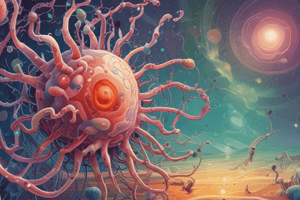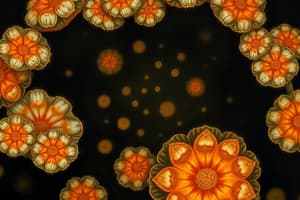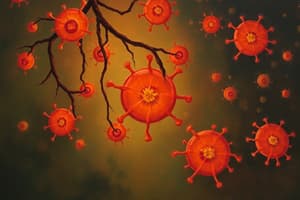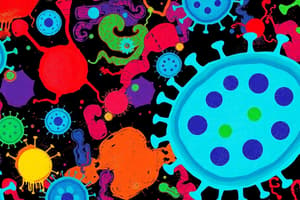Podcast
Questions and Answers
In the context of microbiology, which of the following best describes the function of virulence factors?
In the context of microbiology, which of the following best describes the function of virulence factors?
- To facilitate the lysis and breakdown of bacterial cell walls by the host's immune cells.
- To aid bacteria in causing no harm to the host, thus establishing a commensal relationship.
- To enhance a microbe's ability to evade the host's immune system and colonize tissues. (correct)
- To directly neutralize any toxins secreted by other competing microorganisms.
How would the absence of sterols in the cytoplasmic membrane of a prokaryotic cell primarily affect its function?
How would the absence of sterols in the cytoplasmic membrane of a prokaryotic cell primarily affect its function?
- It would render the membrane more rigid and less able to adapt to temperature changes.
- It would impair the membrane's fluidity and stability, affecting transport and signaling processes. (correct)
- It would enhance the cell's ability to perform sexual reproduction via meiosis.
- It would increase the rate of respiration and electron transport across the membrane.
Which cellular process is uniquely associated with eukaryotic cells but not with prokaryotic cells?
Which cellular process is uniquely associated with eukaryotic cells but not with prokaryotic cells?
- Respiration and electron transport occurring in the cytoplasmic membrane.
- The ability to synthesize proteins using 70S ribosomes.
- Asexual reproduction via binary fission.
- The presence of membrane-bound organelles like mitochondria and endoplasmic reticulum. (correct)
A researcher is trying to classify a newly discovered bacterium. After performing a Gram stain, they observe a spherical shape arranged in grape-like clusters under the microscope. Which of the following is the most appropriate classification based on this information?
A researcher is trying to classify a newly discovered bacterium. After performing a Gram stain, they observe a spherical shape arranged in grape-like clusters under the microscope. Which of the following is the most appropriate classification based on this information?
A scientist discovers a new species of bacteria that is helical-shaped and highly flexible. Which term best describes this bacterial morphology?
A scientist discovers a new species of bacteria that is helical-shaped and highly flexible. Which term best describes this bacterial morphology?
What critical step differentiates Koch’s postulates from simply observing a correlation between a microbe and a disease?
What critical step differentiates Koch’s postulates from simply observing a correlation between a microbe and a disease?
If a researcher observed a bacterium described as pleomorphic in a sample, what would be the most accurate interpretation of this observation?
If a researcher observed a bacterium described as pleomorphic in a sample, what would be the most accurate interpretation of this observation?
Which of the following is the most accurate comparison of the characteristics of prokaryotic and eukaryotic flagella?
Which of the following is the most accurate comparison of the characteristics of prokaryotic and eukaryotic flagella?
A researcher is examining a sample from the human oropharynx. The normal flora present primarily consists of which type of bacteria?
A researcher is examining a sample from the human oropharynx. The normal flora present primarily consists of which type of bacteria?
Which of the following statements best describes the role and characteristics of opportunistic pathogens?
Which of the following statements best describes the role and characteristics of opportunistic pathogens?
Flashcards
What is Microbiology?
What is Microbiology?
A specialized area of biology studying living things usually too small to see without aid.
What are Pathogens?
What are Pathogens?
Microorganisms capable of causing disease in a host.
Opportunistic Pathogen
Opportunistic Pathogen
Microbes that usually don't harm the host, but can cause disease when the body's defenses are compromised.
What is Virulence?
What is Virulence?
Signup and view all the flashcards
Virulence Factors
Virulence Factors
Signup and view all the flashcards
Commensals/Normal Flora
Commensals/Normal Flora
Signup and view all the flashcards
Eukaryotes
Eukaryotes
Signup and view all the flashcards
Bacterial Shape
Bacterial Shape
Signup and view all the flashcards
Baterial Arrangement
Baterial Arrangement
Signup and view all the flashcards
What is Taxonomy?
What is Taxonomy?
Signup and view all the flashcards
Study Notes
Introduction to Microbiology
- Microbiology is a specialized area of biology studying living things usually too small to see without aid
Microorganisms
- Microorganisms include bacteria, fungi, viruses, algae, protozoa, and helminths
Importance of Microbes
- Microbes are ubiquitous and found everywhere, from soil to extreme environments and within other organisms
- They function as photosynthesizers, decomposers, and recyclers
Terminology
- Pathogens are microorganisms capable of causing disease in a host
- Opportunistic pathogens usually do not harm the host but cause disease when the host's defenses are compromised like Pseudomonas aeruginosa
- Virulence is a pathogen's relative capacity to invade and harm host cells
- Virulence factors are bacterial features that help infect a host, avoid the immune system, and assist in colonization, such as adhesins, toxins, and enzymes
- Spreading factors are extracellular enzymes and toxins that destroy host tissue and allow bacterial spread, like hyaluronidase and collagenase
- Commensals/Normal flora are microbes colonizing a host without causing damage and are generally harmless and do not invade tissue/blood
Location and Normal Flora
- Blood and tissue typically have no normal flora
- Skin: Staphylococcus epidermidis
- Oropharynx: Viridans streptococci
- Gastrointestinal tract: Escherichia coli, Bacteroides species
- Vagina: Lactobacillus species
- Urethra: Staphylococcus epidermidis
History of Microbiology
- Antonie Van Leeuwenhoek was the first to describe bacteria in 1976, discovered "animalcules", built the microscope, and is considered the Father of Microbiology
- Louis Pasteur developed the Theory of Biogenesis vs. Spontaneous Generation and invented Pasteurization
- Robert Koch demonstrated the link between microbes and infectious diseases, identified causative agents of anthrax and tuberculosis, and developed techniques for obtaining pure cultures
- Koch's postulates are four steps to confirm if a suspected pathogen is the cause of a disease
- The pathogen must be present in all cases of the disease and absent from healthy animals
- The pathogen must be isolated from the diseased host and grown in pure culture
- The pathogen from the pure culture must cause the disease when inoculated into a healthy, susceptible laboratory animal; the disease must be reproduced when a pure culture of the organism is introduced into a healthy, susceptible host
- The pathogen must be isolated from the inoculated animal and must be shown to be the original organism; the same organism must be reisolated from the experimentally infected host
- Sir Alexander Fleming discovered penicillin
Microbial Classification
- Taxonomy is organizing, classifying, and naming living things
- Concerned with organizing organisms into groups at the levels of Domain, Kingdom, Phylum/Division, Class, Order, Family, Genus, and Species
- Nomenclature involves assigning names using a binomial (two-name) system, e.g., Staphylococcus aureus
- Identification involves determining and recording traits of organisms for taxonomic placement
Prokaryotes vs. Eukaryotes
- Prokaryotes lack a membrane-bound nucleus, and their DNA is free in the cytoplasm within a nucleoid region
- Eukaryotes have a true membrane-bound nucleus with DNA bound by a nuclear membrane and a nucleolus
- Prokaryotes have circular, double-stranded DNA with only exons
- Eukaryotes have linear, double-stranded DNA with exons and introns
- Prokaryotes lack histones in DNA and do not have organized chromosomes
- Eukaryotes have DNA complexed with histones and organized into more than one chromosome
- Prokaryotes may contain plasmids, while plasmids are found only in yeasts in eukaryotes
- Prokaryotes divide asexually by binary fission, whereas eukaryotes divide by mitosis
- Prokaryotes reproduce sexually via transfer of genetic material by conjugation, while eukaryotes reproduce sexually by meiosis
- Prokaryotes possess a cytoplasmic membrane without carbohydrates or sterols
- Eukaryotes have a cytoplasmic membrane with sterols and carbohydrates
- Prokaryotes lack membrane-bound organelles; respiration and electron transport occur in the cytoplasmic membrane
- Eukaryotes have membrane-bound organelles like mitochondria, endoplasmic reticulum, and Golgi apparatus
- Prokaryotic flagella consist of two protein building blocks, whereas eukaryotic flagella are complex with multiple microtubules
- Prokaryotic ribosomes are 70S (smaller), while eukaryotic ribosomes are 80S (larger), except for the 70S ribosomes in mitochondria and chloroplasts
- Prokaryotes are unicellular, while eukaryotes are often multicellular
Microscopy
- The objective lens (closest to the specimen) and ocular lens/eyepiece function together to resolve the image
- The initial image is a real image, and the second is a virtual image that produces the final magnified image
- Total power of magnification is the power of the objective lens times the power of the ocular lens
- A bright-field microscope light path consists of a transillumination light source, a condenser, and ocular lenses
- Maximum magnification is 1000x
- It allows observation of cell morphology (shape/arrangement) and intracellular structures
- The main advantage is that living specimens can be examined
- A disadvantage is that staining kills the microbes
Unicellular Prokaryotic Organisms : Morphology
- Shape is determined by a rigid wall
- Spherical/round cells are coccus (plural: cocci)
- Cylindrical/rod-shaped cells are bacillus (plural: bacilli) or rods
- Helical shapes include twisted/spiral spirochaetes and spirillum
Arrangement
- Arrangement (style of grouping) depends on the plane of successive cell division
- General arrangements include chains, clusters, and palisades (angled pairs)
- Single coccus
- Pairs (diplococci) are cocci that remain in joined pairs after dividing
- Chains (streptococcus) are cocci that divide along one plane and remain connected
- Packets/tetrads are cocci that divide in two planes and remain in groups of four
- Sarcina are cocci that divide in three planes and remain in cube-like groups of eight
- Clusters (staphylococcus) are cocci that divide in multiple planes and form grape-like clusters
Bacillus
- Single (bacillus) where most bacilli appear as a single rod
- Chains of bacillus appear in chains after division
- Comma-shape (vibrio)
- Palisades are bacteria cells at weird angles, resulting from snapping apart their outer cell wall
- Short rods (coccobacilli) are bacilli that are so short and fat they look like cocci
Helical Shapes
- Spirillum (plural:Spirilla) have a helical shape and fairly rigid bodies
- Spirochaetes have a helical shape and flexible bodies that are long, tender, and tightly coiled like telephone wires
Pleomorphic Bacteria
- Pleomorphic bacteria do not have any characteristic shape
- Observed to have different shapes in pure cultures
- Mycoplasma pneumoniae is an example
Studying That Suits You
Use AI to generate personalized quizzes and flashcards to suit your learning preferences.




